如何更新RecyclerView适配器数据?
试图找出更新RecyclerView的适配器有什么问题。
在我获得新的产品列表后,我试图:
-
从创建
ArrayList的片段更新recyclerView,将新数据设置为适配器,然后调用adapter.notifyDataSetChanged();它不起作用。 -
像其他人一样创建一个新的适配器,它适用于他们,但对我没有任何变化:
recyclerView.setAdapter(new RecyclerViewAdapter(newArrayList)) -
在
Adapter中创建一个方法,按如下方式更新数据:public void updateData(ArrayList<ViewModel> viewModels) { items.clear(); items.addAll(viewModels); notifyDataSetChanged(); }然后每当我想更新数据列表时,我都会调用此方法;那没起效。
-
要检查我是否可以以任何方式修改recyclerView,并且我尝试删除至少一个项目:
public void removeItem(int position) { items.remove(position); notifyItemRemoved(position); }一切都保持不变。
这是我的适配器:
public class RecyclerViewAdapter extends RecyclerView.Adapter<RecyclerViewAdapter.ViewHolder> implements View.OnClickListener {
private ArrayList<ViewModel> items;
private OnItemClickListener onItemClickListener;
public RecyclerViewAdapter(ArrayList<ViewModel> items) {
this.items = items;
}
public void setOnItemClickListener(OnItemClickListener onItemClickListener) {
this.onItemClickListener = onItemClickListener;
}
@Override
public ViewHolder onCreateViewHolder(ViewGroup parent, int viewType) {
View v = LayoutInflater.from(parent.getContext()).inflate(R.layout.item_recycler, parent, false);
v.setOnClickListener(this);
return new ViewHolder(v);
}
public void updateData(ArrayList<ViewModel> viewModels) {
items.clear();
items.addAll(viewModels);
notifyDataSetChanged();
}
public void addItem(int position, ViewModel viewModel) {
items.add(position, viewModel);
notifyItemInserted(position);
}
public void removeItem(int position) {
items.remove(position);
notifyItemRemoved(position);
}
@Override
public void onBindViewHolder(ViewHolder holder, int position) {
ViewModel item = items.get(position);
holder.title.setText(item.getTitle());
Picasso.with(holder.image.getContext()).load(item.getImage()).into(holder.image);
holder.price.setText(item.getPrice());
holder.credit.setText(item.getCredit());
holder.description.setText(item.getDescription());
holder.itemView.setTag(item);
}
@Override
public int getItemCount() {
return items.size();
}
@Override
public void onClick(final View v) {
// Give some time to the ripple to finish the effect
if (onItemClickListener != null) {
new Handler().postDelayed(new Runnable() {
@Override
public void run() {
onItemClickListener.onItemClick(v, (ViewModel) v.getTag());
}
}, 0);
}
}
protected static class ViewHolder extends RecyclerView.ViewHolder {
public ImageView image;
public TextView price, credit, title, description;
public ViewHolder(View itemView) {
super(itemView);
image = (ImageView) itemView.findViewById(R.id.image);
price = (TextView) itemView.findViewById(R.id.price);
credit = (TextView) itemView.findViewById(R.id.credit);
title = (TextView) itemView.findViewById(R.id.title);
description = (TextView) itemView.findViewById(R.id.description);
}
}
public interface OnItemClickListener {
void onItemClick(View view, ViewModel viewModel);
}
}
我发起RecyclerView如下:
recyclerView = (RecyclerView) view.findViewById(R.id.recycler);
recyclerView.setLayoutManager(new GridLayoutManager(getActivity(), 5));
adapter = new RecyclerViewAdapter(items);
adapter.setOnItemClickListener(this);
recyclerView.setAdapter(adapter);
那么,我如何实际更新适配器数据以显示新收到的项目?
更新:问题在于gridView的布局如下所示:
<?xml version="1.0" encoding="utf-8"?>
<LinearLayout
xmlns:android="http://schemas.android.com/apk/res/android"
android:orientation="vertical"
android:layout_width="match_parent"
android:tag="catalog_fragment"
android:layout_height="match_parent">
<FrameLayout
android:orientation="vertical"
android:layout_width="match_parent"
android:layout_height="match_parent">
<android.support.v7.widget.RecyclerView
android:id="@+id/recycler"
android:layout_width="match_parent"
android:layout_height="match_parent"
android:clipToPadding="false"/>
<ImageButton
android:id="@+id/fab"
android:layout_gravity="top|end"
style="@style/FabStyle"/>
</FrameLayout>
</LinearLayout>
然后我刚删除了LinearLayout并将FrameLayout作为父级布局。
14 个答案:
答案 0 :(得分:259)
我正在使用RecyclerView,删除和更新工作都很顺利。
1)删除: 从RecyclerView中删除项目有4个步骤
list.remove(position);
recycler.removeViewAt(position);
mAdapter.notifyItemRemoved(position);
mAdapter.notifyItemRangeChanged(position, list.size());
这些代码对我有用。
2)更新数据: 我唯一需要做的就是
mAdapter.notifyDataSetChanged();
您必须在Actvity / Fragment代码中执行所有这些操作,而不是在RecyclerView适配器代码中。
答案 1 :(得分:196)
这是未来访客的一般答案。解释了更新适配器数据的各种方法。该过程每次包括两个主要步骤:
- 更新数据集
- 通知适配器更改
- 如果您使用
notifyDataSetChanged(),则不会执行任何动画。这也可能是一项昂贵的操作,因此如果您只更新单个项目或一系列项目,则不建议使用notifyDataSetChanged()。 - 如果要对列表进行大量或复杂的更改,请查看DiffUtil。
插入单个项目
添加&#34;猪&#34;在索引2。
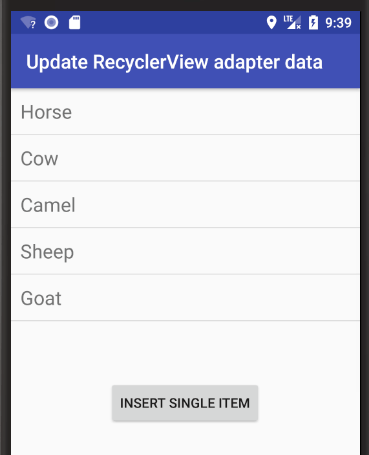
String item = "Pig";
int insertIndex = 2;
data.add(insertIndex, item);
adapter.notifyItemInserted(insertIndex);
插入多个项目
在指数2插入另外三只动物。
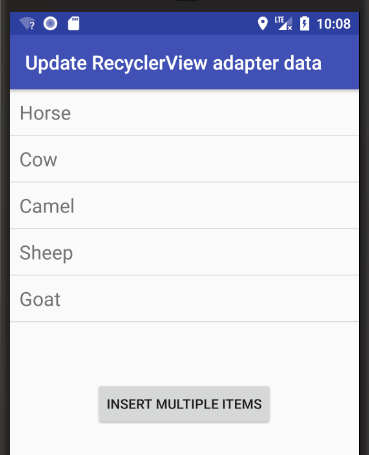
ArrayList<String> items = new ArrayList<>();
items.add("Pig");
items.add("Chicken");
items.add("Dog");
int insertIndex = 2;
data.addAll(insertIndex, items);
adapter.notifyItemRangeInserted(insertIndex, items.size());
删除单个项目
删除&#34; Pig&#34;从列表中。
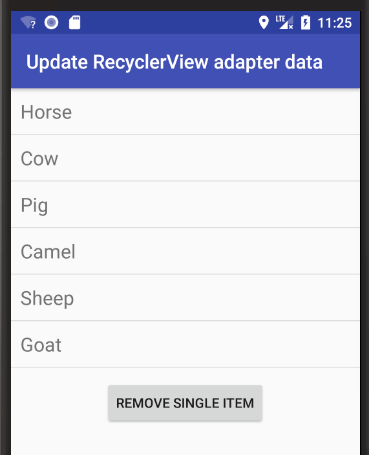
int removeIndex = 2;
data.remove(removeIndex);
adapter.notifyItemRemoved(removeIndex);
删除多个项目
删除&#34; Camel&#34;和#34;绵羊&#34;从列表中。
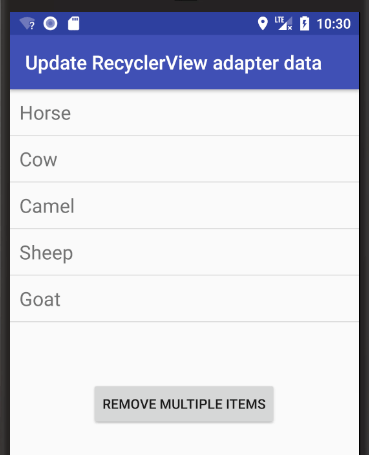
int startIndex = 2; // inclusive
int endIndex = 4; // exclusive
int count = endIndex - startIndex; // 2 items will be removed
data.subList(startIndex, endIndex).clear();
adapter.notifyItemRangeRemoved(startIndex, count);
删除所有项目
清除整个清单。
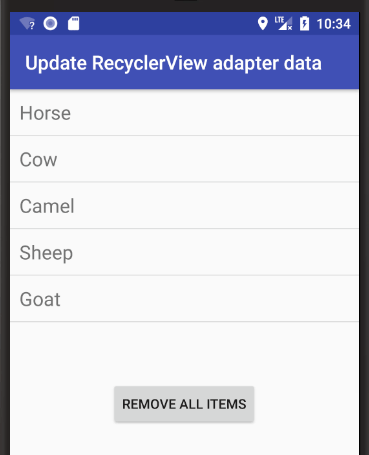
data.clear();
adapter.notifyDataSetChanged();
用新列表替换旧列表
清除旧列表,然后添加一个新列表。
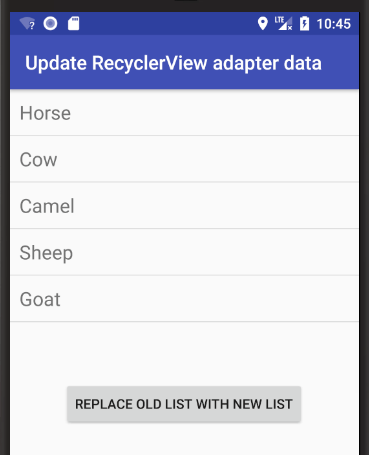
// clear old list
data.clear();
// add new list
ArrayList<String> newList = new ArrayList<>();
newList.add("Lion");
newList.add("Wolf");
newList.add("Bear");
data.addAll(newList);
// notify adapter
adapter.notifyDataSetChanged();
adapter引用了data,因此我没有将data设置为新对象非常重要。相反,我清除了data中的旧项目,然后添加了新项目。
更新单个项目
改变&#34;绵羊&#34;项目,因此它说&#34;我喜欢绵羊。&#34;
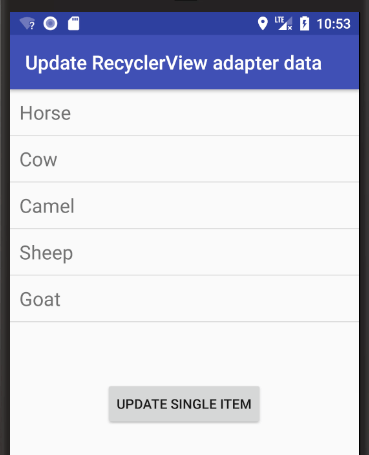
String newValue = "I like sheep.";
int updateIndex = 3;
data.set(updateIndex, newValue);
adapter.notifyItemChanged(updateIndex);
移动单个项目
移动&#34;绵羊&#34;从位置3到位置1。
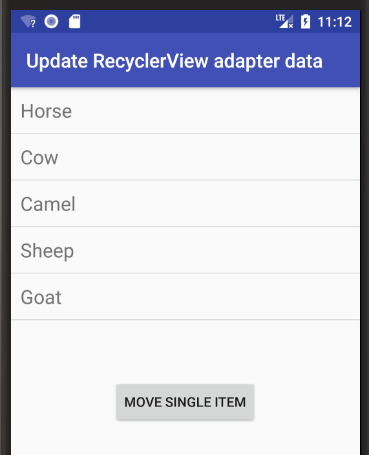
int fromPosition = 3;
int toPosition = 1;
// update data array
String item = data.get(fromPosition);
data.remove(fromPosition);
data.add(toPosition, item);
// notify adapter
adapter.notifyItemMoved(fromPosition, toPosition);
代码
以下是供您参考的项目代码。 RecyclerView适配器代码可以在this answer找到。
MainActivity.java
public class MainActivity extends AppCompatActivity implements MyRecyclerViewAdapter.ItemClickListener {
List<String> data;
MyRecyclerViewAdapter adapter;
@Override
protected void onCreate(Bundle savedInstanceState) {
super.onCreate(savedInstanceState);
setContentView(R.layout.activity_main);
// data to populate the RecyclerView with
data = new ArrayList<>();
data.add("Horse");
data.add("Cow");
data.add("Camel");
data.add("Sheep");
data.add("Goat");
// set up the RecyclerView
RecyclerView recyclerView = findViewById(R.id.rvAnimals);
LinearLayoutManager layoutManager = new LinearLayoutManager(this);
recyclerView.setLayoutManager(layoutManager);
DividerItemDecoration dividerItemDecoration = new DividerItemDecoration(recyclerView.getContext(),
layoutManager.getOrientation());
recyclerView.addItemDecoration(dividerItemDecoration);
adapter = new MyRecyclerViewAdapter(this, data);
adapter.setClickListener(this);
recyclerView.setAdapter(adapter);
}
@Override
public void onItemClick(View view, int position) {
Toast.makeText(this, "You clicked " + adapter.getItem(position) + " on row number " + position, Toast.LENGTH_SHORT).show();
}
public void onButtonClick(View view) {
insertSingleItem();
}
private void insertSingleItem() {
String item = "Pig";
int insertIndex = 2;
data.add(insertIndex, item);
adapter.notifyItemInserted(insertIndex);
}
private void insertMultipleItems() {
ArrayList<String> items = new ArrayList<>();
items.add("Pig");
items.add("Chicken");
items.add("Dog");
int insertIndex = 2;
data.addAll(insertIndex, items);
adapter.notifyItemRangeInserted(insertIndex, items.size());
}
private void removeSingleItem() {
int removeIndex = 2;
data.remove(removeIndex);
adapter.notifyItemRemoved(removeIndex);
}
private void removeMultipleItems() {
int startIndex = 2; // inclusive
int endIndex = 4; // exclusive
int count = endIndex - startIndex; // 2 items will be removed
data.subList(startIndex, endIndex).clear();
adapter.notifyItemRangeRemoved(startIndex, count);
}
private void removeAllItems() {
data.clear();
adapter.notifyDataSetChanged();
}
private void replaceOldListWithNewList() {
// clear old list
data.clear();
// add new list
ArrayList<String> newList = new ArrayList<>();
newList.add("Lion");
newList.add("Wolf");
newList.add("Bear");
data.addAll(newList);
// notify adapter
adapter.notifyDataSetChanged();
}
private void updateSingleItem() {
String newValue = "I like sheep.";
int updateIndex = 3;
data.set(updateIndex, newValue);
adapter.notifyItemChanged(updateIndex);
}
private void moveSingleItem() {
int fromPosition = 3;
int toPosition = 1;
// update data array
String item = data.get(fromPosition);
data.remove(fromPosition);
data.add(toPosition, item);
// notify adapter
adapter.notifyItemMoved(fromPosition, toPosition);
}
}
注释
进一步研究
答案 2 :(得分:40)
这对我有用:
recyclerView.setAdapter(new RecyclerViewAdapter(newList));
recyclerView.invalidate();
创建一个包含更新列表的新适配器(在我的情况下,它是一个转换为ArrayList的数据库)并将其设置为适配器后,我尝试recyclerView.invalidate()并且它有效。
答案 3 :(得分:15)
你有2个选项可以做到这一点: 从适配器刷新UI:
mAdapter.notifyDataSetChanged();
或从recyclerView本身刷新它:
recyclerView.invalidate();
答案 4 :(得分:9)
另一种选择是使用diffutil。它会将原始列表与新列表进行比较,如果有更改,则使用新列表作为更新。
基本上,我们可以使用DiffUtil来比较旧数据和新数据,并让它代表您调用notifyItemRangeRemoved和notifyItemRangeChanged以及notifyItemRangeInserted。
使用diffUtil而不是notifyDataSetChanged的简短示例:
DiffResult diffResult = DiffUtil
.calculateDiff(new MyDiffUtilCB(getItems(), items));
//any clear up on memory here and then
diffResult.dispatchUpdatesTo(this);
//and then, if necessary
items.clear()
items.addAll(newItems)
如果它是一个很大的列表,我会在主线程中执行calculateDiff工作。
答案 5 :(得分:8)
更新listview,gridview和recyclerview的数据
mAdapter.notifyDataSetChanged();
或
mAdapter.notifyItemRangeChanged(0, itemList.size());
答案 6 :(得分:5)
将新数据添加到当前数据的最佳和最酷的方法是
ArrayList<String> newItems = new ArrayList<String>();
newItems = getList();
int oldListItemscount = alcontainerDetails.size();
alcontainerDetails.addAll(newItems);
recyclerview.getAdapter().notifyItemChanged(oldListItemscount+1, al_containerDetails);
答案 7 :(得分:5)
我以不同的方式解决了同样的问题。 我没有从后台线程等待它的数据,所以从一个emty列表开始。
mAdapter = new ModelAdapter(getContext(),new ArrayList<Model>());
// then when i get data
mAdapter.update(response.getModelList());
// and update is in my adapter
public void update(ArrayList<Model> modelList){
adapterModelList.clear();
for (Product model: modelList) {
adapterModelList.add(model);
}
mAdapter.notifyDataSetChanged();
}
就是这样。
答案 8 :(得分:2)
我发现重新加载RecyclerView的一个非常简单的方法就是调用
recyclerView.removeAllViews();
这将首先删除RecyclerView的所有内容,然后使用更新的值再次添加。
答案 9 :(得分:1)
很长一段时间后我得到了答案
SELECTEDROW.add(dt);
notifyItemInserted(position);
SELECTEDROW.remove(position);
notifyItemRemoved(position);
答案 10 :(得分:1)
如果上述评论中没有提及,则对您有用。这可能意味着问题出在其他地方。
我发现解决方案的一个地方就是我将列表设置为适配器的方式。在我的活动中,列表是一个实例变量,我在更改任何数据时直接更改它。由于它是一个参考变量,有一些奇怪的事情发生。所以我将引用变量更改为本地变量并使用另一个变量来更新数据,然后传递给上面答案中提到的addAll()函数。
答案 11 :(得分:1)
这些方法非常有效,可以开始使用基本的RecyclerView。
private List<YourItem> items;
public void setItems(List<YourItem> newItems)
{
clearItems();
addItems(newItems);
}
public void addItem(YourItem item, int position)
{
if (position > items.size()) return;
items.add(item);
notifyItemInserted(position);
}
public void addMoreItems(List<YourItem> newItems)
{
int position = items.size() + 1;
newItems.addAll(newItems);
notifyItemChanged(position, newItems);
}
public void addItems(List<YourItem> newItems)
{
items.addAll(newItems);
notifyDataSetChanged();
}
public void clearItems()
{
items.clear();
notifyDataSetChanged();
}
public void addLoader()
{
items.add(null);
notifyItemInserted(items.size() - 1);
}
public void removeLoader()
{
items.remove(items.size() - 1);
notifyItemRemoved(items.size());
}
public void removeItem(int position)
{
if (position >= items.size()) return;
items.remove(position);
notifyItemRemoved(position);
}
public void swapItems(int positionA, int positionB)
{
if (positionA > items.size()) return;
if (positionB > items.size()) return;
YourItem firstItem = items.get(positionA);
videoList.set(positionA, items.get(positionB));
videoList.set(positionB, firstItem);
notifyDataSetChanged();
}
您可以在Adapter Class或Fragment或Activity中实现它们,但在这种情况下,您必须实例化Adapter才能调用通知方法。在我的情况下,我通常在适配器中实现它。
答案 12 :(得分:1)
我会使用 Kotlin,适配器。
class ProductAdapter(var apples: List<Apples>?= null) : RecyclerView.Adapter<ProductViewHolder>() {
override fun onCreateViewHolder(parent: ViewGroup, viewType: Int): ProductViewHolder {...}
override fun onBindViewHolder(holder: ProductViewHolder, position: Int) {...}
override fun getItemCount(): Int {...}
fun setData(newApples: List<Apples>) {
apples = newApples
}
}
在片段/活动中
val appleAdapter = ProductAdapter()
val recyclerView = binding.appleRecycler // or findViewById or synthetics or whatever.
recyclerView.adapter = appleAdapter
recyclerView.layoutManager = LinearLayoutManager(requireContext())
现在处理片段中的数据变化
fun updateRecyclerData(apples: List<Apples>){
adapter.setData(apples)
adapter.notifyDataSetChanged()
}
updateRecyclerData(applesList)
答案 13 :(得分:0)
我强烈建议您使用[DiffUtil.ItemCallback][1]来处理RecyclerView.Adapter中的更改
fun setData(data: List<T>) {
val calculateDiff = DiffUtil.calculateDiff(DiffUtilCallback(items, data))
items.clear()
items += data
calculateDiff.dispatchUpdatesTo(this)
}
它在后台用AdapterListUpdateCallback处理大多数事情:
/**
* ListUpdateCallback that dispatches update events to the given adapter.
*
* @see DiffUtil.DiffResult#dispatchUpdatesTo(RecyclerView.Adapter)
*/
public final class AdapterListUpdateCallback implements ListUpdateCallback {
@NonNull
private final RecyclerView.Adapter mAdapter;
/**
* Creates an AdapterListUpdateCallback that will dispatch update events to the given adapter.
*
* @param adapter The Adapter to send updates to.
*/
public AdapterListUpdateCallback(@NonNull RecyclerView.Adapter adapter) {
mAdapter = adapter;
}
/** {@inheritDoc} */
@Override
public void onInserted(int position, int count) {
mAdapter.notifyItemRangeInserted(position, count);
}
/** {@inheritDoc} */
@Override
public void onRemoved(int position, int count) {
mAdapter.notifyItemRangeRemoved(position, count);
}
/** {@inheritDoc} */
@Override
public void onMoved(int fromPosition, int toPosition) {
mAdapter.notifyItemMoved(fromPosition, toPosition);
}
/** {@inheritDoc} */
@Override
public void onChanged(int position, int count, Object payload) {
mAdapter.notifyItemRangeChanged(position, count, payload);
}
}
- 我写了这段代码,但我无法理解我的错误
- 我无法从一个代码实例的列表中删除 None 值,但我可以在另一个实例中。为什么它适用于一个细分市场而不适用于另一个细分市场?
- 是否有可能使 loadstring 不可能等于打印?卢阿
- java中的random.expovariate()
- Appscript 通过会议在 Google 日历中发送电子邮件和创建活动
- 为什么我的 Onclick 箭头功能在 React 中不起作用?
- 在此代码中是否有使用“this”的替代方法?
- 在 SQL Server 和 PostgreSQL 上查询,我如何从第一个表获得第二个表的可视化
- 每千个数字得到
- 更新了城市边界 KML 文件的来源?